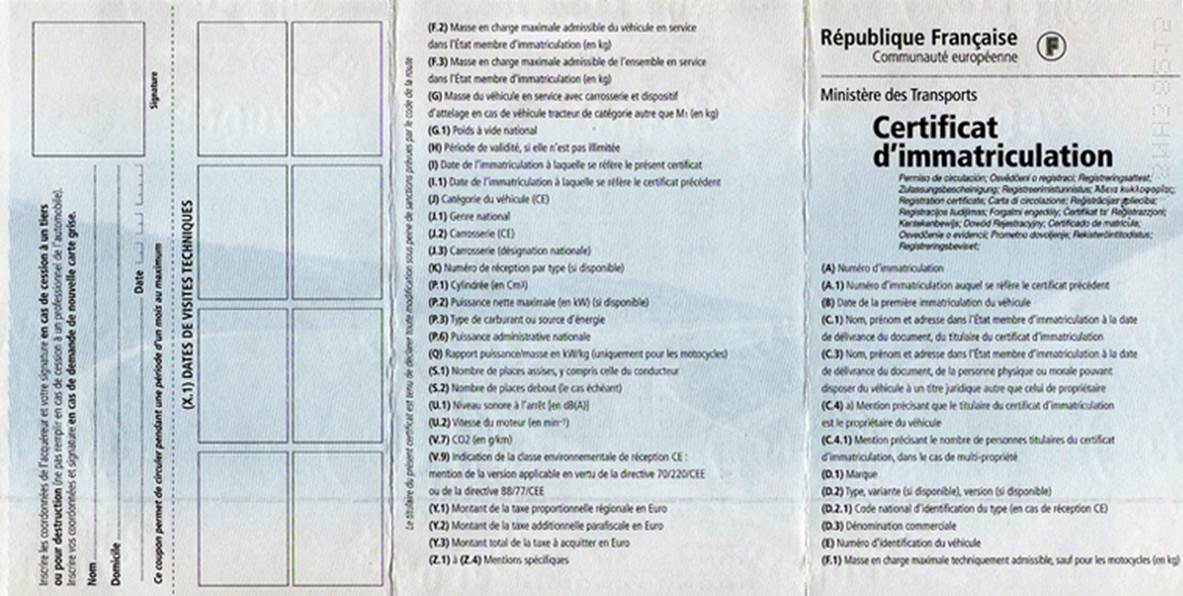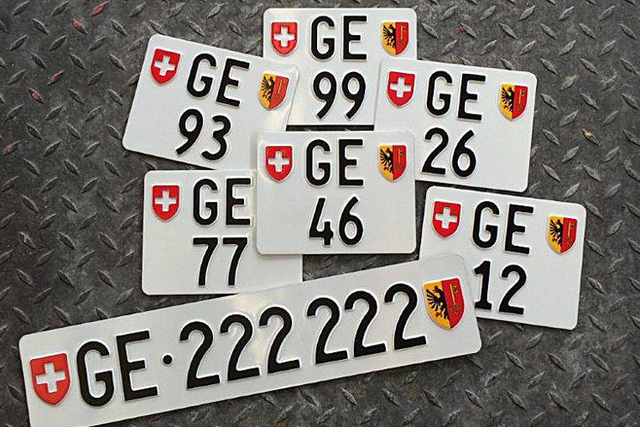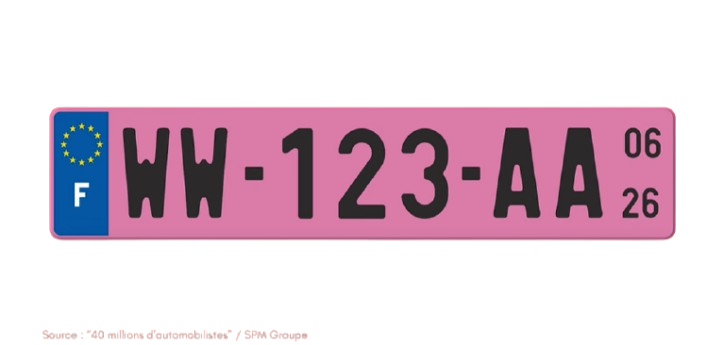Vehicle registration document in France: what information is found on the carte grise?

Publié par Eplaque-8 min de lecture ⏳
Le 14/10/2022-Mis à jour le 20/10/2023

Any car registration document holds a lot of useful information regarding the vehicle. For example, about the power of the car, its fiscal power, how many passengers can travel in it, etc. Below, every single piece of information found on the French equivalent of the V5 registration document is explained. Whether you need to find your VIN number, the weight you car can tow or the emissions of your vehicle, you’ll find the answer below.
What information is found on a vehicle registration document?
The French gray card is structured in headings and fields that make it easy to understand the vehicle registration document. These markers are particularly useful for completing Cerfa forms, the documents used to request things such as a car registration, a change of address, a vehicle ownership transfer, etc. Indeed, they indicate which fields on the vehicle registration document to use to complete the form.
Up to to the field F, the description of the data is written on the French V5C, which greatly facilitates understanding. After that, you will need explanatory material such as the one provided below to know what it refers to.
Field A: registration number
The registration number is the one that appears on your French plates. Since the implementation of the SIV system in 2009, it follows the “AA-111-AA” structure. If your license plate looks different, your vehicle is still in the old FNI system.
Field B: date of first registration of the vehicle
The date on which the vehicle was put into circulation for the first time, which therefore corresponds to the date of creation of the first registration certificate.
Field C: information about the holder(s) of the gray card
The items with a C concern the holder of the gray card:
Field C.1: surname and first name
- C.3: address of the holder of the registration certificate. It must correspond to the main residence (hence the proof of address requested to complete the registration process) of the holder. All official correspondence concerning the vehicle will be sent to this address, in particular electronic tickets
- C.4a: generic mention « IS THE OWNER OF THE VEHICLE ». However, this is not legally true, the gray card is not considered by France as a title deed
- C.4.1: this benchmark concerns any joint holders. It indicates the number of co-holders as well as the name of the first co-holder who appeared on the application for registration
Header D: information about the vehicle
- D.1: brand (for example Peugeot)
- D.2: this field corresponds to a special code which provides information on the type, variant and version of the vehicle
- D.2.1: national type identification code (CNIT) or “mine type”, which indicates whether the vehicle has been subject to an EU, national or an individual type approval
- D.3: commercial name (the model, for example Class C)
Header E: vehicle identification number (VIN)
The vehicle identification number, or VIN, is also known as the “chassis number” in France. This is a unique number that identifies the vehicle. It is widely used to check if a car has been stolen.
Header F: information concerning the maximum weight the car can carry and pull
All the fields of the F. marks are expressed in kilograms:
- F.1: technically permissible maximum laden mass (PTAC), i.e. the maximum weight the vehicle can bear when driving, with its load and its passengers. This weight is defined by the manufacturer
- F.2: maximum permissible laden mass of the vehicle alone in the Member State of registration
- F.3: maximum permissible laden mass of the car, with a trailer or a caravan
Header G: mass of the vehicle in service with bodywork and coupling device in the case of a towing vehicle of a category other than M1
- G.: formerly known as GCW, this is the weight of the vehicle, plus 80 kg (estimated weight of the driver)
- G.1: national empty weight
Header H: period of validity of the registration certificate
In theory, this field is empty since the validity of a gray card is unlimited. However, there are exceptions, such as WW certificates (4 months validity).
Header I: date of registration to which this certificate refers
It is simply the date of issue of the vehicle registration document.
Header J: Vehicle category (CE)
It is in the J fields of the vehicle registration document that we determine to which category the vehicle belongs (car, quad, van, motorcycle, etc.).
Field J.1: national type (type of vehicle, for example VP for a car). Complete list of national codes by category:
- CTTE: Vans (<3,500 kg other than road tractor)
- CAM: Trucks (>3,500 kg other than road tractor)
- CL: Two-wheeled mopeds or unbodied three-wheeled mopeds
- CYCL: Three-wheel mopeds
- MAGA: Self-propelled agricultural machinery
- MTL: Light Motorcycles
- MIAR: Towed machinery and instruments
- MTT1: Motorcycles other than light motorcycles, with maximum net EC power <= 25 kW
- MTT2: Other motorcycles
- QM: Motorized Quadricycles
- REA: Agricultural trailers
- RETC: Trailers for combined transport
- REM: Road trailers
- RESP: Specialized trailers
- SREA: Agricultural semi-trailers
- SRAT: Drawbar semi-trailers
- SRTC: Semi-trailers for combined transport
- SREM: Road semi-trailers
- SRSP: Specialized semi-trailers
- TRA: Agricultural tractors
- TRR: Tractor units
- TCP: Public transport of people
- TM: Motorized Tricycles
- VASP: Specialized self-propelled vehicles
- VP: Passenger cars
- J.2: Bodywork (CE), vehicle gauge according to EU standards
- J.3: Bodywork (national designation), vehicle size according to French standards.
Header K.: approval number
This field is populated only when the vehicle has been imported. In this case, knowing how to read your car registration document can exempt you from COC.
Header P: power and energy of the vehicle
The above elements are crucial to calculate the price of the vehicle registration document (regional tax and taxes on polluting vehicles):
- P.1: displacement (in cc), engine volume (1600 cc for 1.6 l, etc.).
- P.2: maximum net power (in kW), maximum engine power in kilowatts.
- P.3: type of fuel or energy source, 2 letters to specify the fuel used: petrol (ES), diesel (GO), electric (EL)…
- P.6: national fiscal power, the number of CV of the vehicle. This national administrative power defines the price of the registration certificate via the regional tax. We multiply this value by the price set by the region (from 27 to 52 EUR) where the car is registered.
Field Q: power/mass ratio in kW/kg
Vehicle power to weight ratio, only for motorcycles.
S header: number of seated and standing places
- S.1: number of seats, including the driver’s seat. This information on the gray card indicates how many passengers, driver included, can take place on the seats of the vehicle
- S.2: number of standing places. This mark only applies to transport vehicles, such as buses
U header: sound level
Here, knowing how to read your car registration document can determine if your vehicle is making too much noise:
- U.1: sound level when stationary in dB(A), number of decibels emitted when the vehicle is stationary, engine on
- U.2: motor speed (in min-1), motor rotation speed
V header: information concerning vehicle pollution
- V.7: CO2 emissions (in gr/km), indicates the quantity of CO2 emitted by the vehicle at each kilometer (in grams). The higher the number, the more the vehicle pollutes, and the higher the amount of the “bonus écologique” will be when registering the car for the first time in France
- V.9: EC approval environmental class, i.e. the environmental class to which the vehicle belongs according to European standards. In short, it is the EURO norm of the engine. The higher, the better. Critair classification is based on that field
Field X.1: date of the next technical inspection on the date of issue of the gray card
Date on which the vehicle must pass its first or next technical inspection (MOT).
Y header: taxes (price of the gray card)
In Y, you’ll find the breakdown of the taxes and the total price of the French registration document. All amounts are in euros:
- Y.1: amount of the regional tax. It is calculated by multiplying the price of the “cheval fiscal” by the administrative power of the vehicle (field P.6)
- Y.2: amount of the additional parafiscal tax: currently the professional training tax, only for companies
- Y.3: amount of the additional CO2 tax or amount of the ecotax: the ecological penalty or the CO2 tax paid only when registering for the first time a car in France
- Y.4: amount of tax for management of the registration certificate in euros: fees charged for issuing the registration certificate, fixed cost of €11
- Y.5: amount of the fee for delivery of the registration certificate: price of sending the car registration document by post, fixed cost of €2.76
- Y.6: total amount of tax to be paid: total of points Y.1 to Y.5 which give the total cost of the car registration document
Z header: special mentions
The Z field makes it possible to highlight particular characteristics on the registration certificate, so it’s mostly empty. It can show, for example, “collection” for vintage cars classified as such.
- Z.1: this is where it is indicated whether it is a vintage vehicle, an agricultural vehicle (operating number), a demonstration vehicle, a vehicle belonging to the French state, etc.
- Z.2: if the vehicle has special technical characteristics, they are indicated in this mark (number of wheelchair spaces, medical spaces, etc.)
Now you know in depth what information is found on a vehicle registration document in France!
What documents do I need to register a car in France?
Paperwork for registering a car in France will depend on the type of request, the origin of the car, etc. For more info, see our page registering a car in France. In short, you will mostly need:
- A proof of identity
- Copy of the car registration certificate (if second hand)
- Invoice (new) or “certificate de cession (second hand)
- MOT
- A proof of address
- A copy of your driving license
- A proof of insurance
- Quitus fiscal (if registering a car imported from the EU)
- COC (if registering a car imported from the EU)
- 846A certificate (if registering a car imported from a country outside EU)
- Individual approval called RTI in France (if registering a car imported from a country outside EU)
How to transfer ownership of a car in France?
How do I get a duplicate vehicle registration document online?
You can apply with us. How to apply for a duplicate vehicle registration document? We’ll need from you:
- A proof of identity
- Valid French MOT
- A proof of address
- If the document was stolen, proof of registration of a complain (to be made with the form Cerfa 13753)
What is the cost of replacement of a vehicle registration document? To get a copy, around EUR 55 with Eplaque, taxes, shipping and service fee included.
FAQ vehicle registration document
If you notice an error on your logbook, you must request a correction.
The “formula number” is printed in bold on the first page of the document. The first 4 digits correspond to its year of issue. It is available on SIV cartes grises (issued from 2009), it is some kind of reference of the gray card. If your car registration document doesn’t show this number, the date of the certificate must be provided instead.
If you have lost your confidential code, or your vehicle was registered in the old system, you must request a new one via the ANTS website. You can also make you car registration formality with us without it, we don’t need it.
Yes, in France you can scrap any vehicle without its registration document. You’ll have, however, to declare at the police the loss or the theft of the carte grise. With the complaint receipt, you’ll be able to scrap the car without the certificate.
A ton! See above, every field is explained extensively.
It depends who you ask! It can the V5 or the V5C, in other words the logbook. It can also be the Cerfa 13750 form that must be filled to request a car certificate.



Les questions des utilisateurs
geraghty
7 octobre 2025
Eplaque
8 octobre 2025
john mc mahon
3 août 2025
Eplaque
4 août 2025
Anise Hamilton
5 décembre 2024
Eplaque
6 décembre 2024
Alison
13 novembre 2024
Eplaque
14 novembre 2024
Haydn Ebbs
10 octobre 2024
Eplaque
11 octobre 2024
Michelle keating
22 septembre 2024
Eplaque
23 septembre 2024
KAME MEF
11 septembre 2024
Eplaque
12 septembre 2024
Nikola
14 mai 2024
After paying import fees in my country i have applied for registration where my problem begins..
In my country in order to register the car you have to have an original Certificat d'immatriculation from the previous owner. I have a copy.
Is there any way to get the original Certificat d'immatriculation for the vehicle ?
Eplaque
15 mai 2024
Nikola
15 mai 2024
Yes, the car is imported to France from Belgium. I have the original registration certificate from Belgium), but the officials in my country are requesting for the registration certificate for the W plates(only one W, i don't know what kind of plates are those).
I know that this sounds very complicated, so let me try to simplify the timeline:
1. The car is sold in Belgium and registered there (new)
2. The car is imported to France (probably with temporary plates: W-xxxx )
3. The car is sold and exported from France by me (with temporary plates: WW-xxxx)
I have all the documents, except the original registration certificate for W-xxxx(i only have a copy from it).
Is there any way to get the original registration certificate (gray card) for W-858-MW ?
Unfortunately
Thank you very much !
Eplaque
16 mai 2024
You must therefore request registration of a Belgian car purchased in France, the WW is irrelevant. When a foreign car is sold in a foreign country, the seller is supposed to provide the invoice that the original owner provided (at least, this is how it works in France if, let's say, a Belgian dealer sells let's say a Dutch car to a French).
FYI, W plates are dealers plates. It cannot be used to import a car, it's plates that garage uses to perform technical inspections, for a test, or move a car that needs repair. WW are temporary registrations valid 4 months. The registration certificate is a simple A4 sheet, there is no "real" car registration certificate as such, given the nature of the document.
Hopefully this clarifies everything, and you will be able to register your vehicle with the Belgian certificate.
Nikola
18 mai 2024
And yes, i didn't know that in France the registration certificate is a simple A4 sheet, i was looking for a more "official " document.
Anyway, you have helped me a lot and for that I thank you very much.
Eplaque
20 mai 2024
Mindaugas Tolkevičius
9 mai 2024
Eplaque
9 mai 2024